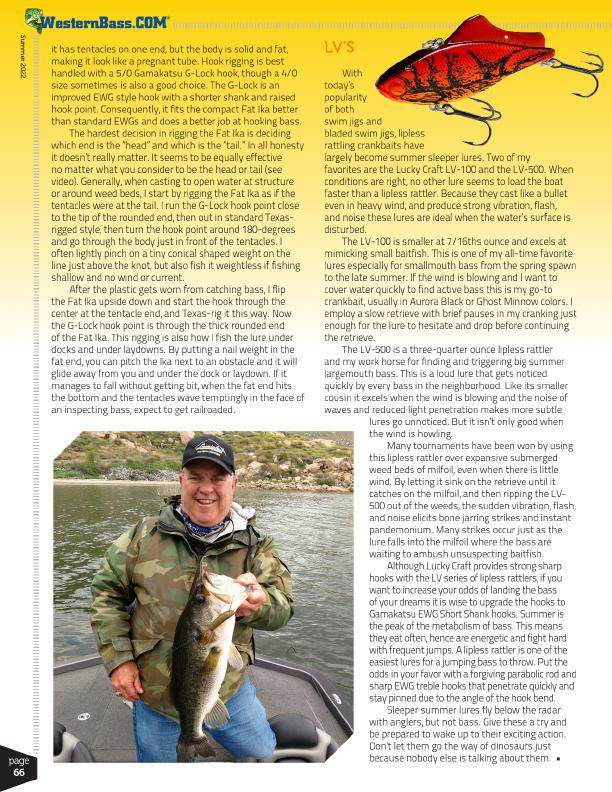
®
Summer 2022
page 66
it has tentacles on one end, but the body is solid and fat, making it look like a pregnant tube. Hook rigging is best handled with a 5/0 Gamakatsu G-Lock hook, though a 4/0 size sometimes is also a good choice. The G-Lock is an improved EWG style hook with a shorter shank and raised hook point. Consequently, it fits the compact Fat Ika better than standard EWGs and does a better job at hooking bass.
The hardest decision in rigging the Fat Ika is deciding which end is the “head” and which is the “tail.” In all honesty it doesn’t really matter. It seems to be equally effective no matter what you consider to be the head or tail (see video). Generally, when casting to open water at structure or around weed beds, I start by rigging the Fat Ika as if the tentacles were at the tail. I run the G-Lock hook point close to the tip of the rounded end, then out in standard Texas- rigged style, then turn the hook point around 180-degrees and go through the body just in front of the tentacles. I often lightly pinch on a tiny conical shaped weight on the line just above the knot, but also fish it weightless if fishing shallow and no wind or current.
After the plastic gets worn from catching bass, I flip the Fat Ika upside down and start the hook through the center at the tentacle end, and Texas-rig it this way. Now the G-Lock hook point is through the thick rounded end of the Fat Ika. This rigging is also how I fish the lure under docks and under laydowns. By putting a nail weight in the fat end, you can pitch the Ika next to an obstacle and it will glide away from you and under the dock or laydown. If it manages to fall without getting bit, when the fat end hits the bottom and the tentacles wave temptingly in the face of an inspecting bass, expect to get railroaded.
LV’S
With today’s popularity of both swim jigs and bladed swim jigs, lipless rattling crankbaits have largely become summer sleeper lures. Two of my favorites are the Lucky Craft LV-100 and the LV-500. When conditions are right, no other lure seems to load the boat faster than a lipless rattler. Because they cast like a bullet even in heavy wind, and produce strong vibration, flash, and noise these lures are ideal when the water’s surface is disturbed.
The LV-100 is smaller at 7/16ths ounce and excels at mimicking small baitfish. This is one of my all-time favorite lures especially for smallmouth bass from the spring spawn to the late summer. If the wind is blowing and I want to cover water quickly to find active bass this is my go-to crankbait, usually in Aurora Black or Ghost Minnow colors. I employ a slow retrieve with brief pauses in my cranking just enough for the lure to hesitate and drop before continuing the retrieve.
The LV-500 is a three-quarter ounce lipless rattler and my work horse for finding and triggering big summer largemouth bass. This is a loud lure that gets noticed quickly by every bass in the neighborhood. Like its smaller cousin it excels when the wind is blowing and the noise of waves and reduced light penetration makes more subtle
lures go unnoticed. But it isn’t only good when
the wind is howling.
Many tournaments have been won by using
this lipless rattler over expansive submerged
weed beds of milfoil, even when there is little
wind. By letting it sink on the retrieve until it
catches on the milfoil, and then ripping the LV-
500 out of the weeds, the sudden vibration, flash,
and noise elicits bone jarring strikes and instant
pandemonium. Many strikes occur just as the
lure falls into the milfoil where the bass are
waiting to ambush unsuspecting baitfish.
Although Lucky Craft provides strong sharp
hooks with the LV series of lipless rattlers, if you
want to increase your odds of landing the bass
of your dreams it is wise to upgrade the hooks to
Gamakatsu EWG Short Shank hooks. Summer is
the peak of the metabolism of bass. This means
they eat often, hence are energetic and fight hard
with frequent jumps. A lipless rattler is one of the
easiest lures for a jumping bass to throw. Put the
odds in your favor with a forgiving parabolic rod and
sharp EWG treble hooks that penetrate quickly and
stay pinned due to the angle of the hook bend.
Sleeper summer lures fly below the radar
with anglers, but not bass. Give these a try and
be prepared to wake up to their exciting action.
Don’t let them go the way of dinosaurs just
because nobody else is talking about them. •